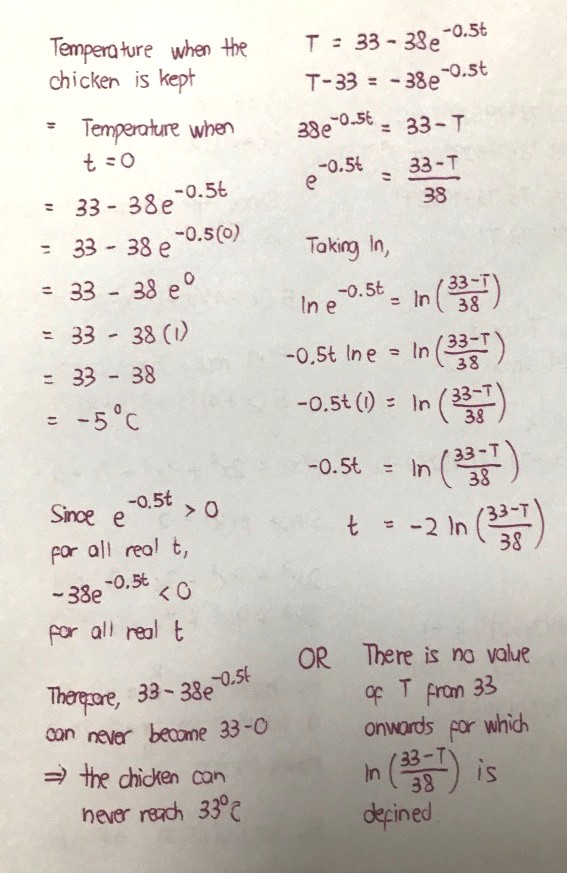Ask Singapore Homework?
Upload a photo of a Singapore homework and someone will email you the solution for free.

See 1 Answer
done
{{ upvoteCount }} Upvotes
clear
{{ downvoteCount * -1 }} Downvotes
An idea
Date Posted:
3 years ago
i still dont understand part (iii)
For part iii we can do either from the original equation or from the transformed equation.
Let's use the original equation first.
T = 33 - 38e^(-0.5t)
Any exponential function a^x, with base a that is more than zero, is known to be always positive for all real values of x. This is an important property to know.
The above is true because e^(-0.5t) can be written as 1 / e^(0.5t), which is clearly a positive number for all real values of t. We cannot obtain a zero out of e^(-0.5t).
So, let's summarise a bit.
e^(-0.5t) cannot equal zero at all because its output value is always positive.
Because of this, 38 * e^(-0.5t) cannot equal zero.
Because of this, 33 - 38 * e^(-0.5t) cannot equal 33 at all.
So, the chicken cannot attain a temperature of 33.
Let's use the original equation first.
T = 33 - 38e^(-0.5t)
Any exponential function a^x, with base a that is more than zero, is known to be always positive for all real values of x. This is an important property to know.
The above is true because e^(-0.5t) can be written as 1 / e^(0.5t), which is clearly a positive number for all real values of t. We cannot obtain a zero out of e^(-0.5t).
So, let's summarise a bit.
e^(-0.5t) cannot equal zero at all because its output value is always positive.
Because of this, 38 * e^(-0.5t) cannot equal zero.
Because of this, 33 - 38 * e^(-0.5t) cannot equal 33 at all.
So, the chicken cannot attain a temperature of 33.
Let's use the transformed equation instead.
t = -2 ln [(33 - T) / 38]
A logarithm loga b is only defined for positive values of a and b. In other words, ln x is only defined for x > 0.
The reason why T cannot equal 33 is that 33 - T becomes zero, for which the term the above expression becomes -2 ln 0, which has no real value. As such, 33 - T must remain positive, or T must always be less than 33.
Hence, the chicken cannot reach a temperature of 33 (but it can come close).
t = -2 ln [(33 - T) / 38]
A logarithm loga b is only defined for positive values of a and b. In other words, ln x is only defined for x > 0.
The reason why T cannot equal 33 is that 33 - T becomes zero, for which the term the above expression becomes -2 ln 0, which has no real value. As such, 33 - T must remain positive, or T must always be less than 33.
Hence, the chicken cannot reach a temperature of 33 (but it can come close).
Let me elaborate a bit more on a^x.
As long as the base is positive, such as 10^x, regardless of our chosen power, the output value remains positive.
Try 10^2. That's 100.
Try 10^0. That's 1.
Try 10^-1. That's 0.1.
Try 10^-5. That's 0.00001. This is still more than 0.
Try 10^-10. That's 0.0000000001. This is still more than 0.
There is no way for which the value of 10^x becomes zero, because 10 raised to a negative power is the same as 1 divided by 10 raised to a positive power, which remains positive.
This is why e^(-0.5t) cannot become zero, meaning to say that 33 - 38 * a non-zero positive number will definitely not equal 33 at all.
As long as the base is positive, such as 10^x, regardless of our chosen power, the output value remains positive.
Try 10^2. That's 100.
Try 10^0. That's 1.
Try 10^-1. That's 0.1.
Try 10^-5. That's 0.00001. This is still more than 0.
Try 10^-10. That's 0.0000000001. This is still more than 0.
There is no way for which the value of 10^x becomes zero, because 10 raised to a negative power is the same as 1 divided by 10 raised to a positive power, which remains positive.
This is why e^(-0.5t) cannot become zero, meaning to say that 33 - 38 * a non-zero positive number will definitely not equal 33 at all.
thanks for the explanation, i understand it now :)





